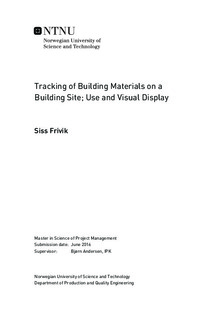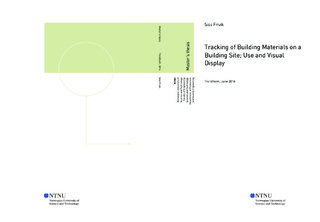| dc.description.abstract | This Master thesis paper is made in connection with the research project SpeedUp, which main objectives are to develop strategic, tactical and operative measures to reduce total project time on big, complex building-and construction projects in Norway. The main objectives for this thesis paper are: to identify possible signal sources from all AIT s (Automatic Information Technologies) on building materials to track these (in real-time) to, and at, the case-study building site Campus Ås: project owner/builder is Statsbygg (The Norwegian Directorate of public Construction and Property agency), used by the independent contractor BundeBygg AS to build Råbygg part 1&2, and see if new signal solutions can be put into place in the future. To observe project planning routines and see how to match this information up with the real-time information captured from the AIT s on the materials used. And to try to utilize this information and design an App, the BFGApp, that can possibly reduce total project time by reducing the (case study s) execution phase time by using the real-time AIT data available. This could also affect future projects, by creating a documented trail for how the material is utilized, and therefore make knowledge transfer to other projects easier.
AIT s found were GPS tracking on ready-made concrete trucks which can track the concrete from the production area till out-pumping/use at the site, Barcode tracking for rebar, and the rest of the main building materials were put in the group AITPicture , were one have to use a picture of the object as tracking. AITPicture can t immediately call up information from the the material since it is not connected to any information, except being recognized as a type of material. Future AIT s could include RFID tags with censors to measure (humidity, temperature, other) in the concrete to track the curing process, and RFID tags (passive, in-between) to track most of the other materials on the building site. This because the RFID tags don t need a straight line of sight to transfer information, the tags have a much longer wear and tear timeline than for instance Barcodes, and a portal on the site entrance would gather the information when the material is delivered.
The main project planning Statsbygg is doing, includes Gant diagram in MS Project for weekly development/progress, general meetings, safety rules framework (HMS), meetings and inspections on the site, to keep everyone in the loop: the Web hotel solution Interaxio for answers and questions, BIM to visual and technical use (at all levels from the HQ to the BIM-kiosks at the site). Interaction between the three levels were through contracts/bids, e-mails, phone, meetings and FTF communication. They use BIM, Interaxio, MS Project and Excel as systems. The independent contractor BundeBygg AS uses Viscenario to make deviation reports. The communication between BundeBygg AS and the suppliers were made mainly by meetings, phone and confirming order e-mails. The material departure from supplier production site is, depending on the AIT solution of the company, either made by following a GPS signal, scanning out from production site and onto a truck, or packing lists, till only waybills. The logistics were made by several different solution, from own trucks, to hired companies. The common ground was that all the drivers needed to do a safety class before entering the building site, making this a deciding factor in the shipping planning.
The BFGApp (BigFriendlyGiantApp) idea was to easy visualize the material utilization progress (real-time vs planned material use) as a part of the building process-production, so trends and progress could be used to create a feedback loop. This feedback loop could be used to adjust, change, make production processes more refined, and by this maybe reduce the execution phase of the project. In addition, a documented trail could make knowledge transfer easier to future projects and therefore maybe reducing the planning phase time. This idea was found to be difficult in practice, it is not enough material planning up front that the App could utilize. At present time, it is solved by expanding the App functions by routing the ordering of the materials though the BFGApp. This provides a planned material usage before the actual use and can be used together with the AIT s data to get real-time progress reports. The App is therefore divided into 4 parts; App Scan-Take picture, App Order, App Supplier and at last App Status. This new BFGApp could then be used as the original idea was intended (via a more complex function and design) in addition to centralize much of the information that dealt with all material ordering and use. This can also be used to get financial real-time progress, be in education (games), create documentation trails and can make knowledge transfer between projects easier, among some.
Much more work is remaining; program the structure for the BFGApp so it can be a functional App, tests it with the available data and further development is needed.
| |

